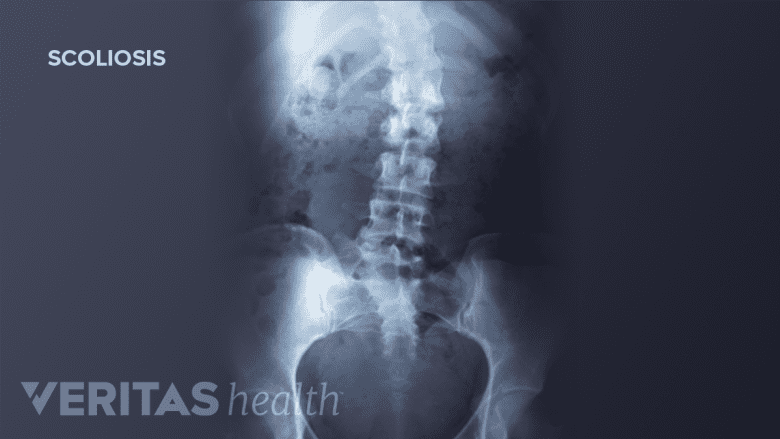Idiopathic scoliosis is usually first identified during a regular checkup with a pediatrician or a routine screening at school; or perhaps a parent or teacher happens to notice and comments on the possible sideways curvature of the spine.
An official diagnosis of idiopathic scoliosis requires X-ray confirmation of the abnormal lateral curvature and spinal rotation, as well as ruling out other possible causes for the deformity (such as Scheuermann's disease, juvenile disc disorder, or ankylosing spondylitis).
In This Article:
Adam’s Forward Bend Test
The first step toward getting an idiopathic scoliosis diagnosis is typically the Adam’s forward bend test, which primarily looks for abnormal spine rotation.
This test involves a healthcare professional observing the patient bending forward at the waist 90 degrees with arms stretched toward the floor and knees straight. From this position, most scoliosis signs that present as asymmetry are clearly visible in the spine and/or trunk of the body, such as:
- One shoulder or shoulder blade is higher than the other
- Rib cage appears higher on one side (also called a rib hump)
- One hip appears higher or more prominent than the other
- The waist appears uneven
- The body tilts to one side
- One leg may appear shorter than the other
The Adam’s forward bend test can be useful in detecting scoliosis located in the upper or mid back, which is where idiopathic scoliosis usually occurs. However, the forward bend test is not as effective at detecting scoliosis in the low back because it does not involve rib rotation.
Scoliometer to Measure Spine Rotation
As part of the forward bend test, the clinician might use a scoliometer, also called an inclinometer, to estimate the angle of trunk rotation (ATR). While the patient is still bending forward, the clinician can put the scoliometer flat on the back in the area or areas where the asymmetry looks the greatest.
See Specialists Who Treat Back Pain
As a general rule, if an ATR of at least 5 degrees is recorded, the patient will either be scheduled for a follow-up exam or referred to a doctor who can image the back for more accurate scoliosis testing.1Coelho DM, Bonagamba GH, Oliveira AS. Scoliometer measurements of patients with idiopathic scoliosis. Braz J Phys Ther. 2013;17(2):179-84.,2Horne JP, Flannery R, Usman S. Adolescent idiopathic scoliosis: Diagnosis and management. Am Fam Physician. 2014; 89(3):193-198. X-ray imaging is needed to measure the degree of the curve and confirm scoliosis.
Cobb Angle Measurement
Finding the Cobb angle helps clinicians diagnose the severity of scoliosis.
The lateral curve of scoliosis is described by the Cobb angle. Using an X-ray of the full spine, the Cobb angle is found by drawing a perpendicular line from the spine’s most-tilted vertebra above the sideways curve’s apex and a second perpendicular line from the most-tilted vertebra beneath the apex. The angle formed where those two lines meet is the Cobb angle.
A Cobb angle of at least 10 degrees is typically considered the borderline for a scoliosis diagnosis.
See Cobb Angle Measurement and Treatment Guidelines
Key Components of a Scoliosis Diagnosis

The level of skeletal maturity dictates scoliosis treatment in kids.
When diagnosing idiopathic scoliosis, there are 3 key components to take into consideration:
- Lateral curvature. The lateral (sideways) curvature of the spine is measured by the Cobb angle. The bigger the Cobb angle, the greater the spinal deformity.
- Axial rotation. In addition to the sideways curvature, the spine abnormally rotates along the vertical axis. Spinal rotation can affect rib rotation, as well as curve rigidity.
- Skeletal maturity. Often estimated by the Risser sign (amount of calcification at the hip bone’s ridged top as seen on the same X-ray as the Cobb angle), the amount of skeletal maturity remaining is critical to making scoliosis treatment decisions in children and teens.
Understanding these components of a scoliosis diagnosis can help the medical team evaluate the severity of the curve, likelihood for progression, and which treatment options could be best.
See Bracing Treatment for Idiopathic Scoliosis
Idiopathic Scoliosis Is a Diagnosis of Exclusion
Idiopathic means a condition is of unknown cause. As such, idiopathic scoliosis technically cannot be diagnosed until other types of scoliosis are ruled out. Other types of scoliosis could include:
- Congenital scoliosis. This type of scoliosis is present from birth and is the result of the spine not forming properly.
- Neuromuscular scoliosis. Many types of neuromuscular conditions can lead to muscle problems in the back that result in scoliosis. A few examples include cerebral palsy and myelodysplasia.
- Degenerative scoliosis. Also called adult onset scoliosis, this type of degenerative scoliosis results from the deterioration of the facet joints in the spine.
- Nonstructural scoliosis. This type of scoliosis, also known as functional scoliosis, occurs due to a temporary cause that only affects lateral curvature without spinal rotation. For example, a difference in leg heights could potentially cause a sideways curve in the spine that is corrected with a shoe insert.
Scoliosis will usually be classified as idiopathic if it was not present at birth and cannot be traced to a neuromuscular, degenerative, or other cause.

